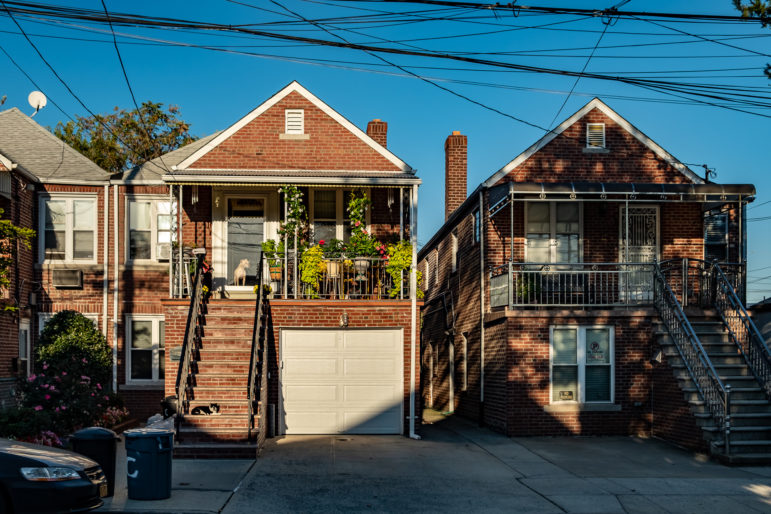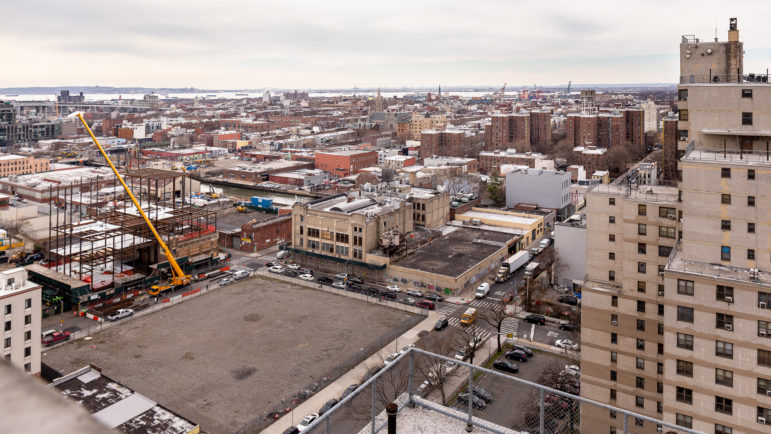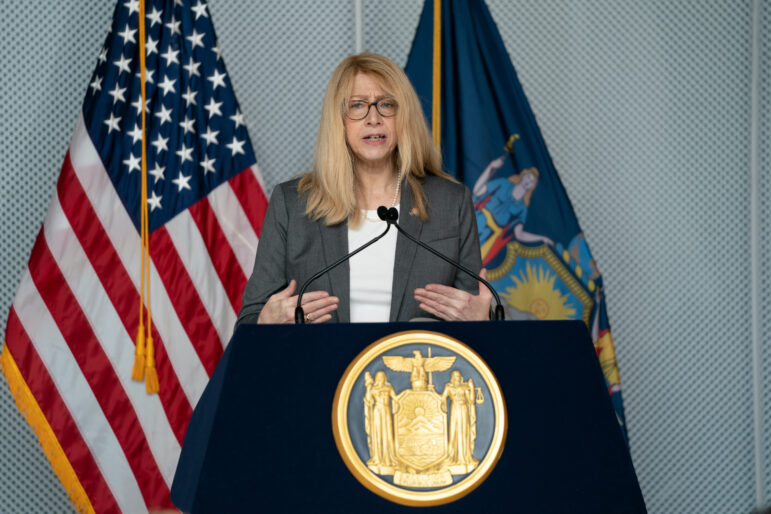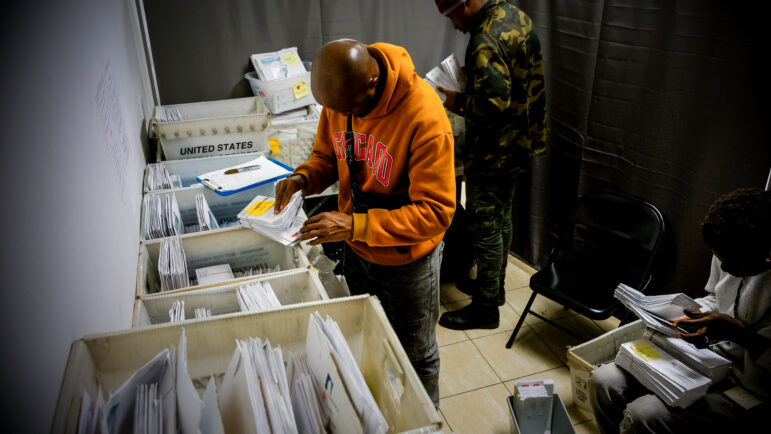Next year will mark a critical time for New York land use and housing policies, as the city faces a looming evictions crisis and the de Blasio administration will push to approve its final neighborhood rezonings.

Adi Talwar
Homes on Tomlinson Avenue in Morris Park, The Bronx.Weeks before president-elect Joseph Biden is inaugurated into the White House, the federal eviction and foreclosure moratorium, an order that temporarily halts residential evictions for nonpayment of rent and mortgages, will end. National housing advocacy groups say the country could see millions of evictions in the coming year–an estimated 30 to 40 million households, according to one August report–unless the federal government addresses the looming economic crisis.
A majority of those eviction filings, approximately 71 percent by January 2021, would be made up of households with annual incomes less than $50,000, according to one projection published in September.
On Jan. 1, New York’s own eviction and foreclosure moratorium will expire. It covers non-payment cases or eviction warrants filed before March 7th, and applies to residential and commercial tenants and homeowners who can prove pandemic-related financial hardships.
Housing advocates and the real estate industry both agree that federal, state and local governments will have to pass critical housing relief legislation in order to bring economic stability for both tenants and property owners, and for the sake of economic recovery.
But more importantly, the pandemic has cast a spotlight on policies–including those related to land use and housing–which have disproportionately impacted low-income households and divested communities. In the coming year, policy makers will have to examine and find equitable paths to mitigate those impacts while facing an estimated $10 billion budget gap.
Here is a roundup of what will likely be the biggest issues related to New York City housing and land use in 2021:
Evictions and foreclosures
The Biden transition team announced a seven-point plan to address the novel Coronavirus pandemic, including emergency funding for state and local governments for rental assistance as well as no-interest forbearance, or mortgage payment relief, for households financially impacted by pandemic.
But that won’t happen until at least Inauguration Day. In the meantime, a September report estimated that New York State alone could see between 800,000 to 1.23 million households unable to pay rent and at risk for eviction, as well as 730,000 eviction filings and between $2.5 to $3.4 billion in rent debt by the start of the next administration.
Hundreds of tenant groups have already held rent strikes over the last six months, while housing advocacy groups such as the Housing Justice for All coalition push for the state legislature to pass stronger policies to protect tenants.
Advocacy groups are likely to continue urging state lawmakers to act on several pieces of legislation in the new year, including the Emergency Housing Stability and Displacement Prevention Act, which would protect residential and commercial tenants from filings and evictions throughout the crisis, plus an additional year. Another bill, the Rent and Mortgage Cancellation Act of 2020, would cancel rents and mortgage payments for the duration of the crisis, with some financial relief for landlords who demonstrate “financial hardship” due to the pandemic. And lastly the Housing Access Voucher Program, would provide housing vouchers for eligible individuals and families who are homeless, or who face an imminent loss of housing. Landlords groups have also expressed support for the housing voucher program.
Homelessness
As of Nov. 30 there were 35,829 adults and 17,914 children, totalling 53,743 individuals, in homeless shelters across the city. That’s an improvement since 2017, when the number reached an estimated 63,000 people in city shelters –– the highest ever recorded, according to data collected by the Coalition for the Homeless.
But the pandemic has further exacerbated both the city’s homelessness and hunger crises. At the start of the crisis, the city began rapidly shifting homeless households into hotel shelters so they can quarantine and safely socially distance, though de Blasio has said the use of hotels is intended to be temporary. The city has also sped up the process for vulnerable households to qualify for programs such as the One Shot Deal, which provides emergency financial assistance to households facing an unexpected situation or event.
Advocates say more can be done, and have called for the city to do things like increase its number of Safe Haven beds and offer more substantial, ongoing support to New Yorkers even after they leave the shelter system.
Tax Lien Program
In August, City Limits reported on elected officials who raised concerns over the city’s tax lien program—reborn under former Mayor Rudy Giuliani—which allows the Department of Finance to hold annual lien sales to collect unpaid property taxes and other charges, such as unpaid water bills. Lawmakers have called for the program to end, saying it disparately impacts communities of color. That legislation is up for a City Council vote in the coming months.

Adi Talwar
The public review process for the city’s plan to rezone parts of Gowanus, Brooklyn, will start in January.Rezonings
In March, Mayor Bill de Blasio issued an emergency order to halt the Uniform Land Use Review Procedure (ULURP), the city’s public land use review process, due to the pandemic. After a months-long hiatus, ULURP virtually restarted this fall.
There are two public rezonings currently underway—Gowanus in Brooklyn and SoHo and NoHo in Manhattan—both of which are expected to be certified, and start the ULURP process, in January. Another private rezoning proposed along the Flushing waterfront could see a City Council vote before the end of the year (the end of the ULURP process).
The Gowanus rezoning would apply to 80 blocks of the neighborhood and could create an estimated 8,200 new apartments by 2035, including 3,000 affordable units, according to the city. It may also include funding for much-needed repairs at three NYCHA complexes in the neighborhood—a crucial demand and the “bottom line” made by community members and local Councilmembers Brad Lander and Stephen Levin, however the city has not made a decision on if they will meet it. Lander previously told City Limits that his team has been in discussions with the city over including NYCHA funding in the rezoning plan.
The SoHo and NoHo rezoning aims to bring affordable housing to the high-opportunity, transit-rich neighborhoods, while keeping true to the contextual tradition of the area and institute flexible policies to support live-work and arts or cultural spaces. It’s a critical test for the city to see if it can successfully build affordable housing in a largely middle- to upper-class neighborhood, and housing advocacy groups are watching carefully for the outcome.
Both projects are part of de Blasio’s housing plan to rezone 15 city neighborhoods, to create more density for both market-rate and affordable housing. So far the administration has successfully approved seven rezonings; efforts to rezone parts of Southern Boulevard in the Bronx and Bushwick in Brooklyn fell apart over the past year.
The Special Flushing Waterfront District is a private rezoning application to create a 29-acre waterfront special district with nine buildings, including 1,725 new apartments, a hotel,new roads, public waterfront open space, plus retail and offices. This November, the City Council pushed back its final vote on the proposal to December, after councilmembers questioned the applicants the impact of the rezoning and raised issues about the number of affordable units included in the plan.
The Flushing project could potentially be impacted by an ongoing lawsuit, filed by a coalition of community groups in June, which says the city should have required an environmental impact study be conducted for the project. The lawsuit is currently going through the courts.
The NYCHA Blueprint plan
In July, the New York City Housing Authority announced a comprehensive restructuring of the city’s public housing in an effort to fund decades of neglected repairs. The “Blueprint” plan, which would cost a whopping $40 billion, would create a preservation trust to control NYCHA’s buildings, allowing it to tap into varied federal funding sources to generate revenue, then use those monies as collateral to borrow to pay for repairs.
This November, NYCHA started accepting public commentary on the plan and will continue doing so until Dec. 28. The undertaking will require extensive support from the U.S. Department of Housing and Urban Development (HUD) and Congress.
Inequity in housing and land use
Over the past few years, there has been growing contention over how the de Blasio administration has implemented its land use policies––largely aimed at low-income, divested neighborhoods. Critics say those policies have led to deep inequity, spurring gentrification, overdevelopment and shifting demographics which have impacted longtime residents and small businesses. This contention has filtered down into private rezonings, like in Industry City, where CEO Andrew Kimball withdrew his application to expand the Sunset Park office campus this fall after facing intense opposition from the community and the local Councilmember Carlos Menchaca.
In October, after a two year study and a series of community engagement efforts, the city released its Where We Live report, a comprehensive list of recommendations to mitigate the impact of prejudiced housing policies. But the plan was criticized by advocates for not going far enough, and for lacking concrete details.
Association for Neighborhood & Housing Development (ANHD) called the report a “missed opportunity,” saying that while it acknowledged the impact of land use policies on low-income communities of color, “its recommendations do not go nearly far enough to address the problems it names, while even those with the most promise seem divorced from any true plan or commitment to make them real.”
“This is all the more egregious in light of the disparities the COVID pandemic has laid bare, the mobilization of the Black Lives Matter movement, and the fierce urgency of action they rightfully demand,” read a statement from the group last month.
Last year December, Public Advocate Jumaane Williams introduced a bill which would mandate a racial impact study for city land-use actions that require an environmental review. The Where We Live report also made a similar recommendation, but gave no details on which indicators it would use such an analysis.
Between the city’s report and Williams’ legislation, housing advocates say there is an opportunity to re-examine how land use decisions and processes occur in New York City, especially as the city moves to rebound from the pandemic.









